The distinct, tart and tangy flavor of the kumquat, a close relative of citrus, is distinctive enough to make you form your own opinion the minute you bite into the edible sweet rind for the very first time and feel an explosion of tart juice hit the roof of your mouth.
It’s a flavor that must be experienced to be understood. Even if you aren’t won over at first bite, the well-behaved little ornamental trees are simply irresistible when laden with their golden, egg-shaped fruits in winter. Grow them in the garden as shrubs or small trees if you live in warm climates (zones 8b to 11); otherwise purchase them for the winter as houseplants to brighten up your space.
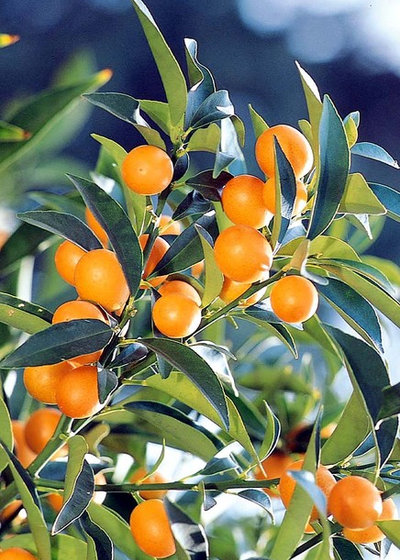
Monrovia
Botanical name: Fortunella spp
Common name: Kumquat
Origin: Southeast Asia
Where it will grow: Hardy to 15 degrees (USDA zones 8b to 11; find your zone)
Water requirement: Moderate to low once established
Light requirement: Full to partial sun
Mature size: Slow growing to 8 to 15 feet tall
Benefits and tolerances: Edible small fruits; fine foliage; the size makes it well suited to small gardens
Seasonal interest: Flowers in summer; the fruits ripen from fall through winter; the evergreen foliage looks good all year long
When to plant: Fall, winter or spring
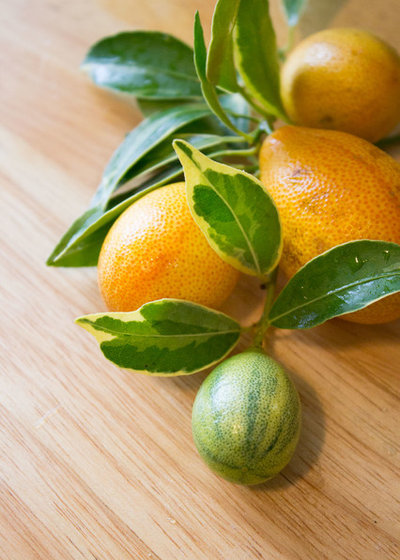 Distinguishing traits.
Distinguishing traits. The most distinguishable feature of kumquats is that they can be eaten whole, rind and all. Acidic types like ‘Nagami’ and ‘Centennial’ (shown) balance out their tart juice with a sweet and chewable rind, while types like ‘Meiwa’ are nearly sweet throughout. All kumquats can be eaten out of hand, though they can also be candied, made into marmalade or used as edible garnishes.
Rather than disappoint yourself by expecting acidic kumquat types to taste anything but, embrace their sour flavor by treating them as limes and lemons rather than miniature oranges. My friend Bill Outlaw once made a key lime pie for his college students at Florida State, asking that they identify the secret ingredient that he changed. Not a single one noticed that the key limes had in fact been replaced by kumquats. Instead of accompanying beverages and entrees with a boring lemon, try slipping in a kumquat or two for a colorful alternative with a sweet and edible rind.
 Varieties.
Varieties. Describing the differences between sweet and sour types isn’t quite like comparing apples to oranges — more like comparing tangerines to limes. Not all kumquats are as sour as the
‘Nagami’ (
Fortunella margarita) sold most commonly at grocery stores or in nurseries.
- ‘Meiwa’ (Fortunella crassifolia) is much sweeter and more agreeable tasting for those expecting something akin to an orange, so it is widely regarded as the best variety for eating fresh out of hand and is gaining in popularity.
- ‘Fukushu’ (Fortunella obovata ‘Fukushu’) and ‘Marumi’ (Fortunella japonica) are popular for their round fruits and are often sold as houseplants on dwarfing rootstocks.
- ‘Centennial’ (shown) is usually sold as an ornamental, but its fruit is just as tasty as that of the others.
In addition to the handful of kumquat species available, there are enough hybrids to make your head spin: from
mandarinquats to
limequats,
citrangequats to
orangequats, to name a few.
‘Nippon’ orangequat and ‘
Indio’ mandarinquat are favored for their sweet flavors.
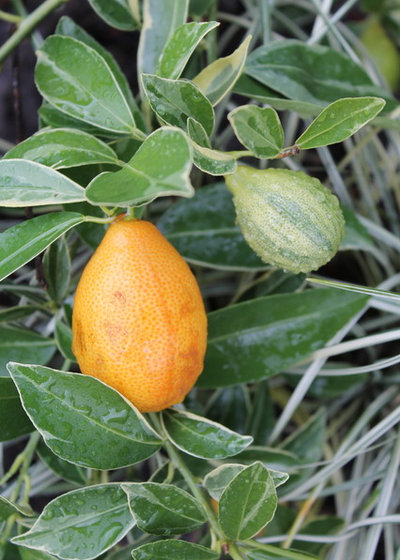 How to use it.
How to use it. The only variety (‘Nagami’) offered at grocery stores has a strong and acidic flavor that some would call an acquired taste. Die-hard fans will insist that you should sink your teeth into the thin, sweet rinds and eat the fruits whole as if they were candy, but the uninitiated are often put off by the over-the-top tartness of the juice inside. Just think grapefruit, but with the sourness of a lemon, and you’ll have a pretty good idea of the kumquat’s appeal (or lack thereof).
Even if you haven’t yet joined the ranks of dedicated kumquat poppers, there are many reasons to grow them yourself. Indeed their small size, slow growth, finely textured foliage, fragrant white summer flowers and ornamental little orange fruits combine to make kumquats one of the most attractive citrus varieties around.
While mandarins, oranges, lemons and the like require ample space to accommodate their unruly and sometimes spiny branches, kumquats can be maintained as short hedges or small standard trees for decades. This also means that they make great houseplants for a sunny windowsill or sunroom, where winter fruits can delight your guests and summertime blossoms can perfume the room with their spicy fragrance.
Shown: ‘Centennial’
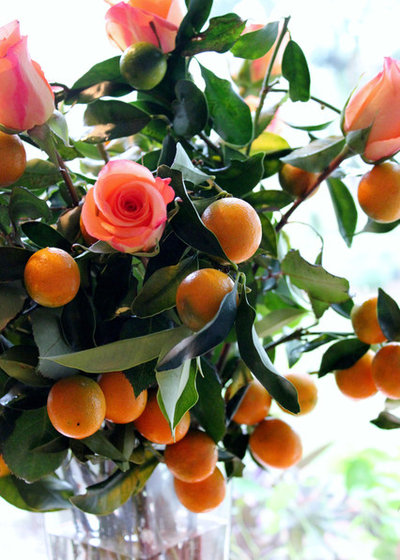
Another clever use for kumquats is as a long-lasting and edible addition to floral arrangements, like in this impromptu mixing of roses and ‘Meiwa’ by my friend Caroline Binder of Cowlick Cottage Farm.
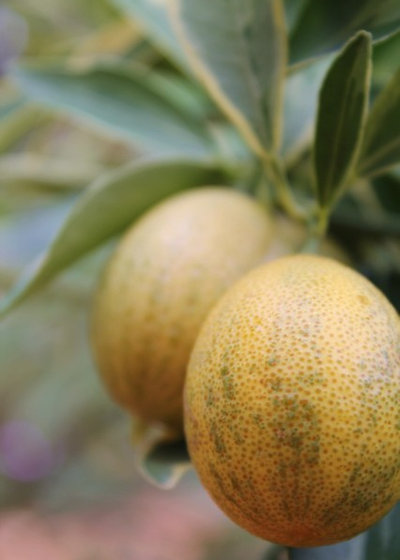 Planting notes.
Planting notes. Growers in zones 8b to 11 can plant kumquats directly in the ground. Choose a site with good drainage (where water doesn’t collect) that gets at least eight hours of direct sunlight. Since kumquats don’t grow as large or as quickly as other citrus varieties, you can space them 8 feet apart if you’re growing them as trees, or 5 feet apart to form a hedge. While kumquats are hardy to 15 degrees Fahrenheit, newly planted specimens are more sensitive to frost and should be covered when it’s in the forecast.
Scale insects and mealybugs sometimes appear as crusty scales and fuzzy white clumps on the undersides of the leaves and where the leaves meet the stems, especially on trees grown in containers. Treat these pests with insecticidal soap or a neem product according to the package’s instructions.
Water plants deeply so that the root zone is thoroughly saturated, but do not allow them to sit in water for too long, as it will cause the roots to rot. Fertilize according to the package’s instructions if you notice problems like yellowing or patchy leaves.
How to Keep Your Citrus Trees Well Fed and Healthy
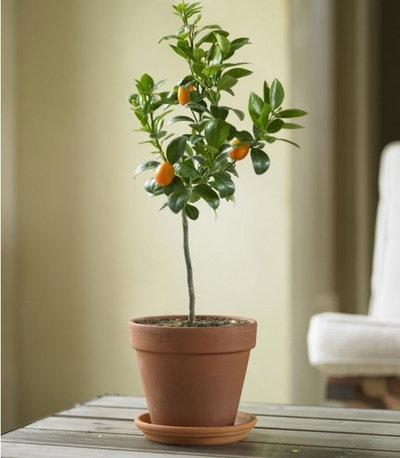
VivaTerra
Fukushu Kumquat Topiary - $95
Kumquats grown as houseplants will do best if kept in a cool location, such as an unheated room or unheated greenhouse (between 32 and 55 degrees Fahrenheit) for the winter. This will push the plants into dormancy so that they’ll be able to handle the lower light and humidity encountered indoors, while still letting the fruit ripen.
If placed in a brightly lit bathroom or greenhouse for winter, kumquats will continue to produce leaves all winter. After the last chance of frost in spring, begin moving container-grown kumquats outdoors by placing them in successively brighter locations each day. This will prevent the leaves from getting sunburned.
See more edible gardening ideas





